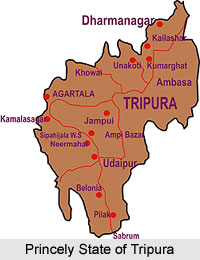 The Princely State of Tripura was one of the native states during the rule of the British Empire in India. During the early 19th century, the region was appointed as one of the princely states of India under the indirect rule of the British administration. The region covered a total area of 4,116 sq m and comprised of a total population of 513,952 in the year 1941. Tripura state was located to the north-east of the mouths of the Ganga River, and was bounded by the British Province of Assamv on the north and by the Province of Bengal on the south. Tripur was the name of the 40th mythical ruler of the region. In the year 1911, the princely state of Tripura included 1 town and 1,463 villages. The territory was under the Eastern States Agency and after 1936, came under the administration of the Bengal States Agency.
The Princely State of Tripura was one of the native states during the rule of the British Empire in India. During the early 19th century, the region was appointed as one of the princely states of India under the indirect rule of the British administration. The region covered a total area of 4,116 sq m and comprised of a total population of 513,952 in the year 1941. Tripura state was located to the north-east of the mouths of the Ganga River, and was bounded by the British Province of Assamv on the north and by the Province of Bengal on the south. Tripur was the name of the 40th mythical ruler of the region. In the year 1911, the princely state of Tripura included 1 town and 1,463 villages. The territory was under the Eastern States Agency and after 1936, came under the administration of the Bengal States Agency.
The Princely State of Tripura was appointed as one of the Salute states of India with a gun salute of 13 guns. The native ruler, who held the title of Maharaja, exercised administrative and jurisdictional powers over the state. Tripura state was segregated into 6 units for administrative purposes. There was also a separate judiciary. The princely state did not pay any tribute to the British government of India and there were no engagements between the 2 governments. The native ruler had large holdings of land in British India, which was known as Chakla Roshanabad. It generated better revenues than the Maharaja`s own State of Tripura. The British courts have always decided the disputed successions that involved the devolution of the holdings. Thus their rulings generally fixed the succession to the royal throne or gadi of the princely state of Tripura. The native ruler of the state held the title of Raja until 1919 and later was styled as Maharaja.
The ruling Rajputs of the state descended from Dhrujya, who was a prince of the Chandravanshi ruling family. It is considered the territory of Tripura was established in the 1st century AD by Tipras, hill people from China. In the early 17th century, the Mughal forces changed the lowlands of Tripura into a zamindari and renamed it as Roshanabad. The British East India Company recognized the rule of the Manikya rajas in the hilly regions after the year 1785. A sanad embodied the family law of succession in 1904. The Raja could appoint the successor of his successor from among the male members of his family. The last ruler of the princely state of Tripura in 1947 was the 185th of his line.
After the country achived independence and the withdrawal of the British administration on 15th August 1947, the princely state of Changbhakar was acceded to the newly formed Dominion of India, also known as the Union of India. Presently, Tripura is a state in North East India and is regarded as one of the Seven Sister States.



















